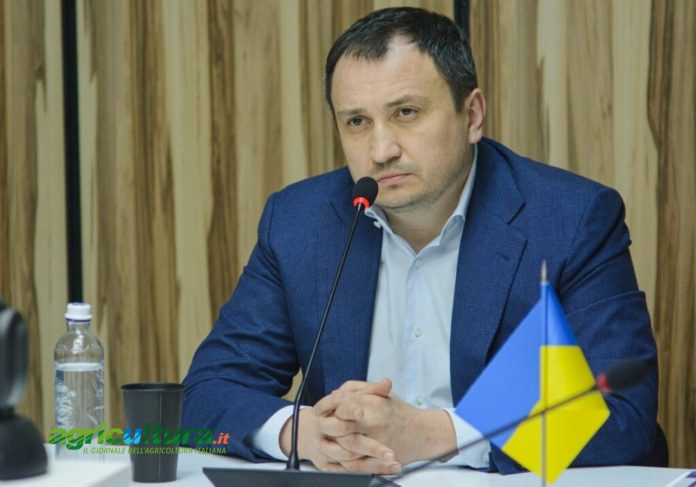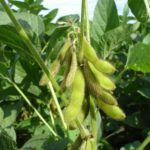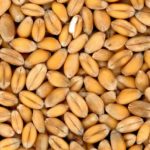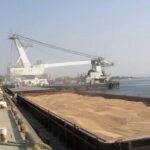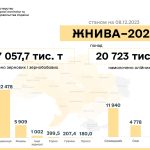ROMA – The war in Ukraine, after the armed invasion of Russia on 24 February 2022, has changed the face, geography and economy of European agriculture and not only Ukrainian. We talked about it day after day.
Two years after that date, Ukrainian Agriculture Minister Mykola Solskyi was a guest at agricultura.it, with whom we spoke about what has happened in these twenty-four months, the difficulties and prospects, what is between the top 5 agricultural exporting countries in the world, Ukraine.
Mr. Solskyi, two years after Russia’s full-scale invasion, what is the situation in Ukrainian agriculture?
There are a lot of problems associated with hostilities in our country. Firstly, we lost more than 20% of agricultural land – 7 million hectares.
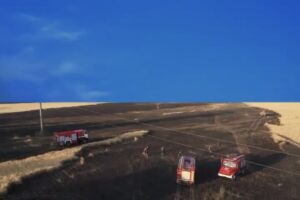 The second problem is mined land. In agricultural land there were mines and shells, even if hostilities are no longer taking place in this area. To begin with, everything must be examined. And then mine. It’s massive. Last year, more than 200 thousand hectares of agricultural land were demined, another 512 thousand hectares are planned to be cleared in 2024. But the war is still ongoing. There are occupied territories, they have to be examined and possibly cleared after the liberation, and this is millions of hectares.
The second problem is mined land. In agricultural land there were mines and shells, even if hostilities are no longer taking place in this area. To begin with, everything must be examined. And then mine. It’s massive. Last year, more than 200 thousand hectares of agricultural land were demined, another 512 thousand hectares are planned to be cleared in 2024. But the war is still ongoing. There are occupied territories, they have to be examined and possibly cleared after the liberation, and this is millions of hectares.
The third point. One of the main problems during these two years was the blocking of ports. For understanding, this led to the fact that the price of grain for the Ukrainian farmer was 2.5 times lower than for any farmer in the world. Just imagine the level of damage.
In general, the Ukrainian agrarian sector for two years of a full-scale war has suffered more than 80 billion US dollars. direct losses. Such data are presented by the World Bank in the report on estimates of losses and needs for the restoration of Ukraine (RDNA3). The largest category of damage is damaged and destroyed agricultural machinery worth 5.8 billion US dollars.
Experts estimate the damage caused by the theft or destruction of already produced agricultural products at $1.97 billion, damage due to damage to granaries – $1.8 billion, damage caused by perennial plantations – $398 million, livestock – $254 million, aquaculture and fisheries – $35 million.
What were the most difficult and hardest moments?
The hardest thing was at the beginning, there was no understanding of how the situation would develop further, whether we could sow, collect, sell, what would happen to export. Then it became clear that the Ukrainian agrarian business is quite mobile, quickly reoriented, finds new opportunities, ways to solve problems. It was not easy for us, but we became more confident in our own abilities.
How have the main Ukrainian production, especially wheat, changed?
With the beginning of a full-scale war, the production of all directions in the agricultural sector decreased. In 2021, the wheat sowing area was 6.4 million hectares, and in 2022 – it was only 5.2 million hectares, and in 2023 – 4.7 million hectares. The sowing areas for barley and sunflower, which are also export crops, decreased as well.
Ukrainian farmers continued to sow and work: what do they need?
Among the main problems of farmers is the lack of working capital, shortage of personnel, expensive logistics, limited export, insufficient amount of mineral fertilizers etc.
We have a significant support for farmers from international donors. For example, interest compensation at expensive credit rates. This is a medium-sized business program. For small farmers, there is a program to compensate for losses per hectare and per animal. Separately, a program was launched to issue grants for greenhouses and orchards. There is a program to restore irrigation. These are support programs that are necessary, especially in war conditions. After all, they enable agriculture, although difficult, to continue to work.
How did the export take place: by land, by sea, in what ways and what are the difficulties in delivery?
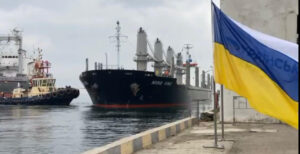 Russia’s full-scale war against Ukraine has destroyed traditional logistics routes for Ukrainian exports. The sea routes through which Ukraine exported 90% of its exports before the war were blocked by Russian troops.
Russia’s full-scale war against Ukraine has destroyed traditional logistics routes for Ukrainian exports. The sea routes through which Ukraine exported 90% of its exports before the war were blocked by Russian troops.
In May 2022, with the support of the EU, an alternative route was launched for the export of agricultural products from Ukraine, as well as the import of necessary goods. These are the so-called “Solidarity Lanes”.
In July 2022, the Black Sea Grain Corridor was launched. It was an agreement between Ukraine, the UN, Turkey, and between the UN, Turkey and the Russian Federation on a sea corridor for the export of Ukrainian grain. July 17, 2023, Russia unilaterally withdrew from the agreement. After that, the Russian army began to systematically bomb the ports. Thus, about 300 thousand grains were destroyed, port infrastructure was damaged.
In August 2023, Ukraine was able to organize its sea corridor from the Black Sea ports of Greater Odessa. Today, this route again passes almost 90% of Ukrainian agricultural export, as it was before the full-scale invasion of Russia. In particular, in December 2023, 7 million 300 thousand tons of grain, oil and meal were exported from Ukraine. Of this, more than 6 million tons by sea and only 1 million tons by land through neighboring countries. The price in the ports of Greater Odessa is more competitive for exporters than on dry land.
We are also actively developing an alternative export route – across the Danube River to Romanian ports.
Did you feel the closeness of European institutions?
The support of the European Union is very important for us and we are sincerely grateful to our good friends in Europe for their systematic support and understanding.
But what about Italy? Have you spoken to the Italian minister?
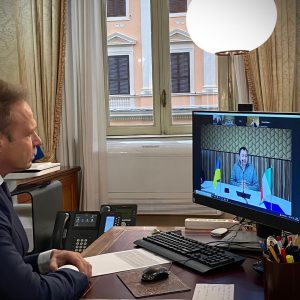 Yes, we periodically communicate with Mr. Francesca Lollobrigida. The last time we met and talked with him was during the 16-th Berlin Conference of Ministers of Agriculture. Italy is a reliable ally and partner for us. We are sincerely grateful for Italy’s participation in the grain initiative of the President of Ukraine “Grain from Ukaine”, for its support in our struggle for victory over the enemy.
Yes, we periodically communicate with Mr. Francesca Lollobrigida. The last time we met and talked with him was during the 16-th Berlin Conference of Ministers of Agriculture. Italy is a reliable ally and partner for us. We are sincerely grateful for Italy’s participation in the grain initiative of the President of Ukraine “Grain from Ukaine”, for its support in our struggle for victory over the enemy.
Italy helps Ukrainian farmers in the restoration of agricultural machinery, in demining agricultural land, in the use of the latest technologies in agriculture.
Ukraine’s goal is to join NATO and the European Union, will this change the agriculture of your country?
The biggest challenge of accession is that Ukrainian farmers from entrepreneurs will turn into recipients of EU subsidies. Farmers in some European countries live on subsidies – this is both a plus and a huge minus for them. Why are Ukrainian agricultural companies now competing on equal terms with European ones? Because Ukrainian agriculture developed without subsidies.
Ukraine’s accession to the EU will change the values of Ukrainian agriculture: do you foresee difficult negotiations?
Yes, we understand that it will not be easy.
Finally: Two years on, can you send a message to European farmers, including Poland’s neighbors?
 We understand the problems of European farmers, and Polish farmers as well. In most countries, the problems of farmers are the same. Our farmers also have similar problems and claims to the authorities, but our war and protests are now prohibited by law due to martial law. Now the most important thing for all citizens of Ukraine, including farmers, is victory.
We understand the problems of European farmers, and Polish farmers as well. In most countries, the problems of farmers are the same. Our farmers also have similar problems and claims to the authorities, but our war and protests are now prohibited by law due to martial law. Now the most important thing for all citizens of Ukraine, including farmers, is victory.
We all understand and share the concerns of all our neighbors, but at the same time we ask partners and friends not to forget in what realities we are currently working. And it is also important in each issue to approach its solution calmly and balanced, without emotions. For example, let’s take the story about sugar. They now want to limit the export of sugar to some EU countries. Now in Europe it costs twice higher in compare with 2022. Restrictions on sugar in such a situation may lead to its further rise in price. Or, for example, there is Brazilian sugar. For some reason, no one is talking about restricting its exports. We understand the complexity of the situation and all the nuances, are ready to take into account any wishes, discuss all issues. But let’s not do anything impulsively and unreasonably.










